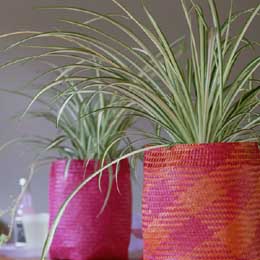 |
Chlorophytum comosum
Name - Chlorophytum comosum, spider plant. The word chlorophytum is
from the Greek chloros meaning green and phuton for plant. It is pronounced KLORO-fiy-tum.Description
- This rewarding houseplant is graceful, easy and quick to grow (ideal for a beginner),
and should last for many years. Spider plants have long, narrow, curving bright
green leaves with either a cream centre or cream edges. The plant will grow up
to 46 cm in height and width. It produces delicate rosettes of white flowers on
long stems and these become independent plants with aerial roots that can be potted
on.Origin - Originally from the subtropical areas of South Africa.
It was introduced as a houseplant in the mid-nineteenth century.Family
- LiliaceaeVarieties - The green-leaved species are tolerant of a wide
range of conditions, except cold and bright sunlight, which bleaches the leaves.
Its variegated cultivars are more popular: 'Variegatum' has creamy white leaf
margins; 'Vittatum' has a white band down the centre; while 'Bonnie' has twisted
leaves. The arching leaves and stems are best displayed by growing plants in a
hanging basket.Care Tips - A bright or semi-shady, well ventilated
position, away from direct sunlight in normal room temperature. Tolerates dry
air, although this tends to make the leaf tips go brown. Pull off dead leaves.
Water 2-3 times a week in summer, allowing the soil almost to dry out between
watering, and once a week in winter. Add liquid food to the water every 2 weeks
in summer. Misting should keep the leaves clean as they are too brittle to wipe.
Repot every spring.Propagation - Roots and stems can be divided, the
old soil carefully removed and smaller plants repotted. As the plantlets produce
roots, these can be potted on in a small pot beside the parent. When established
with new leaves of their own, these plantlets can be cut away from the parent.
Alternatively, plantlets can be rooted in water and then potted at any time during
the year.Trivia - Research has shown that in a small room a single
specimen removes 98 per cent of the carbon monoxide in the air.
>>
Click here for healthy houseplants
pages

back |
|
|

